Transformer: Attention is All You Need
Transformer란?
- 기계 번역을 위한 새로운 모델로 이전에 등장했던 Attention 메커니즘을 극대화하여 뛰어난 번역 성능을 기록했다.
- 최근 자연어 처리 모델 SOTA(State-of-the-Art)의 기본 아이디어는 거의 모두 트랜스포머를 기반으로 하고있다.
- 트랜스포머는 RNN 기반 모델이 가진 단어가 순서대로 들어오기 때문에 처리해야하는 시퀀스가 길수록 연산 시간이 길어진다는 단점을 해결하기 위해 등장한 모델이다.
- 모든 토큰을 동시에 입력받아 병렬연산하기 때문에 GPU 연산에 최적화되어 있다.
- 인코더, 디코더로 표현된 사각형을 각각 인코더 블록과 디코더 블록이라고 한다.
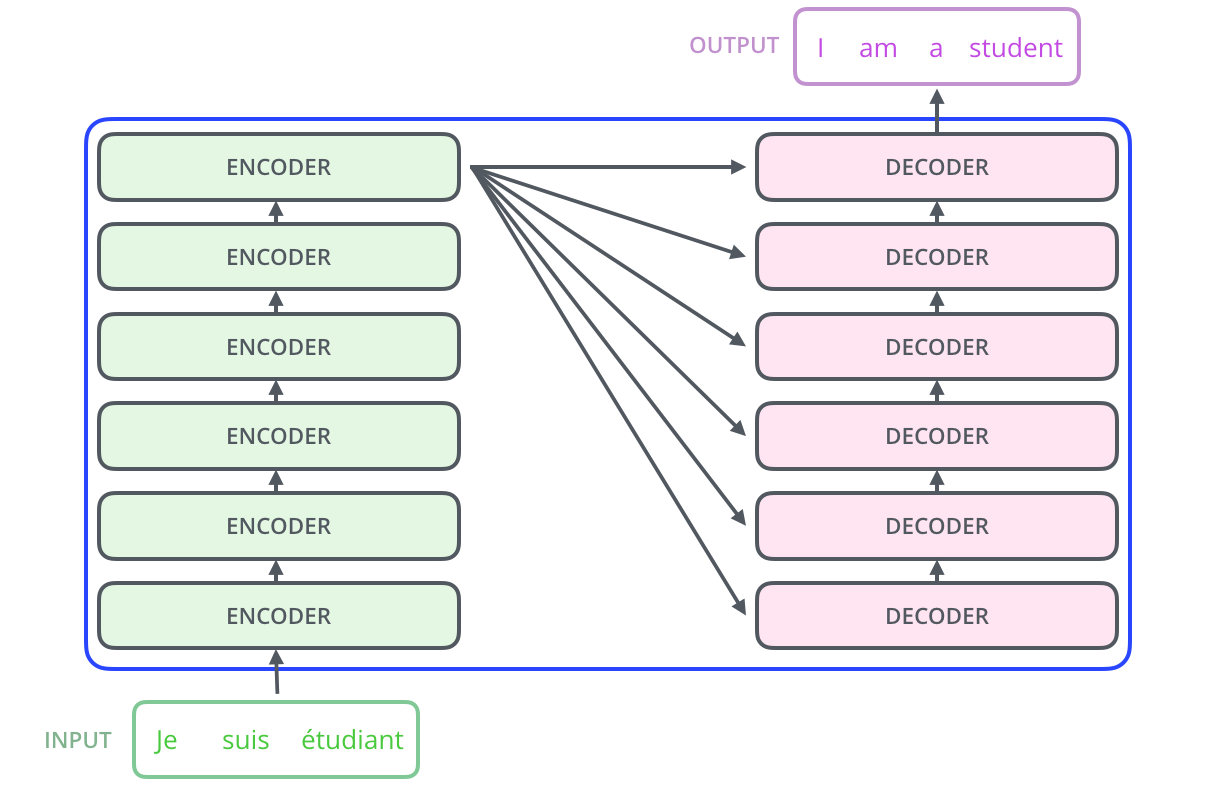
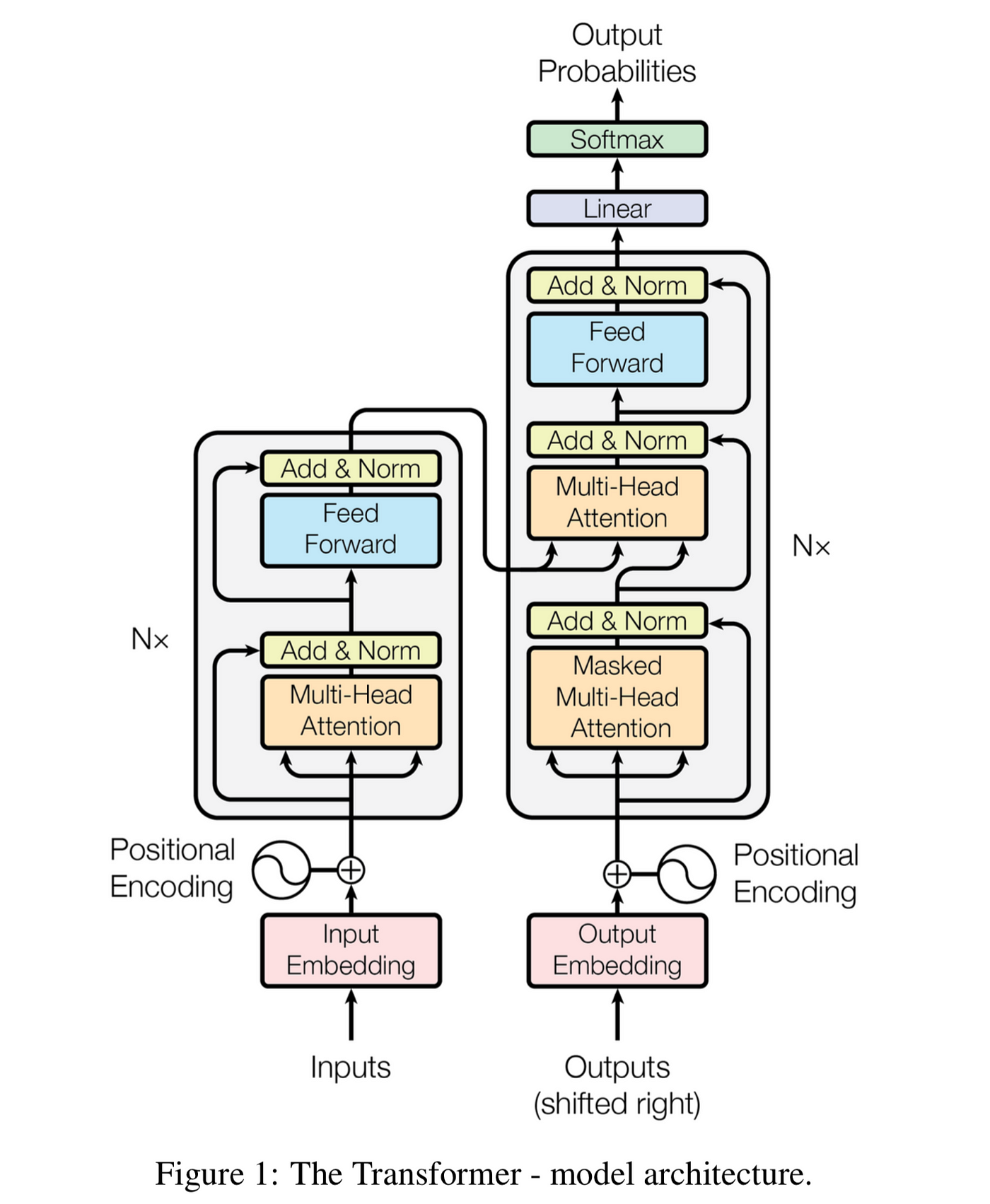
- 위 그림은 트랜스 포머의 구조를 나타낸 그림이다.
- 커다란 회색 블록 2개가 각각 인코더 블록, 디코더 블록이다.
- 인코더 블록은 크게 2개, 디코더 블록은 3개의 sub-layer로 나뉜다.
Positional Encoding
- 트랜스포머에서는 병렬화를 위해 모든 단어 벡터를 동시에 입력받는데, 위치정보를 제공하기 위해 포지셔널 인코딩을 진행한다.
시각화
- 일정한 패턴이 있는 벡터가 만들어지는 것을 볼 수 있다.

1 | |
Self-Attention
- 제대로 번역하려면 지시 대명사가 어떤 대상을 가리키는지 알아야 한다.
- 그렇기 때문에 트랜스포머에서는 번역하려는 문장 내부 요소의 관계를 잘 파악하기 위해서, 문장 자신에 대해 어텐션 메커니즘을 적용하는데, 이를 Self-Attention이라고 한다.

- 기존 Attention과의 차이는 각 벡터가 모두 가중치 벡터라는 점이다.
- q는 분석하고자 하는 단어에 대한 가중치 벡터이다.
- k는 각 단어가 쿼리에 해당하는 단어와 얼마나 연관있는지 비교하기 위한 가중치 벡터이다.
- v는 각 단어의 의미를 살려주기 위한 가중치 벡터이다.
- Self-Attention은 세가지 가중치 벡터를 대상으로 어텐션을 적용한다.
- 특정 단어의 q 벡터와 모든 단어의 k 벡터를 내적한다. 내적을 통해 나오는 값이 Attention 스코어가 된다.
- 트랜스포머에서는 이 가중치를 q, k, v 벡터 차원 $d_k$ 의 제곱근인 $\sqrt{d_k}$로 나누어준다.(계산값을 안정적으로 만들어주기 위한 계산 보정)
- Softmax를 취해준다. 이를 통해 쿼리에 해당하는 단어와 문장 내 다른 단어가 가지는 관계의 비율을 구할 수 있다.
- 마지막으로 v 각 단어의 벡터를 곱해준 후 모두 더하면 Self-Attention 과정이 마무리된다.
Self-Attention 과정
가중치 행렬 $W^Q, W^K, W^V$ 로부터 각 단어의 쿼리, 키, 밸류(q, k, v) 벡터를 만들어낸다.
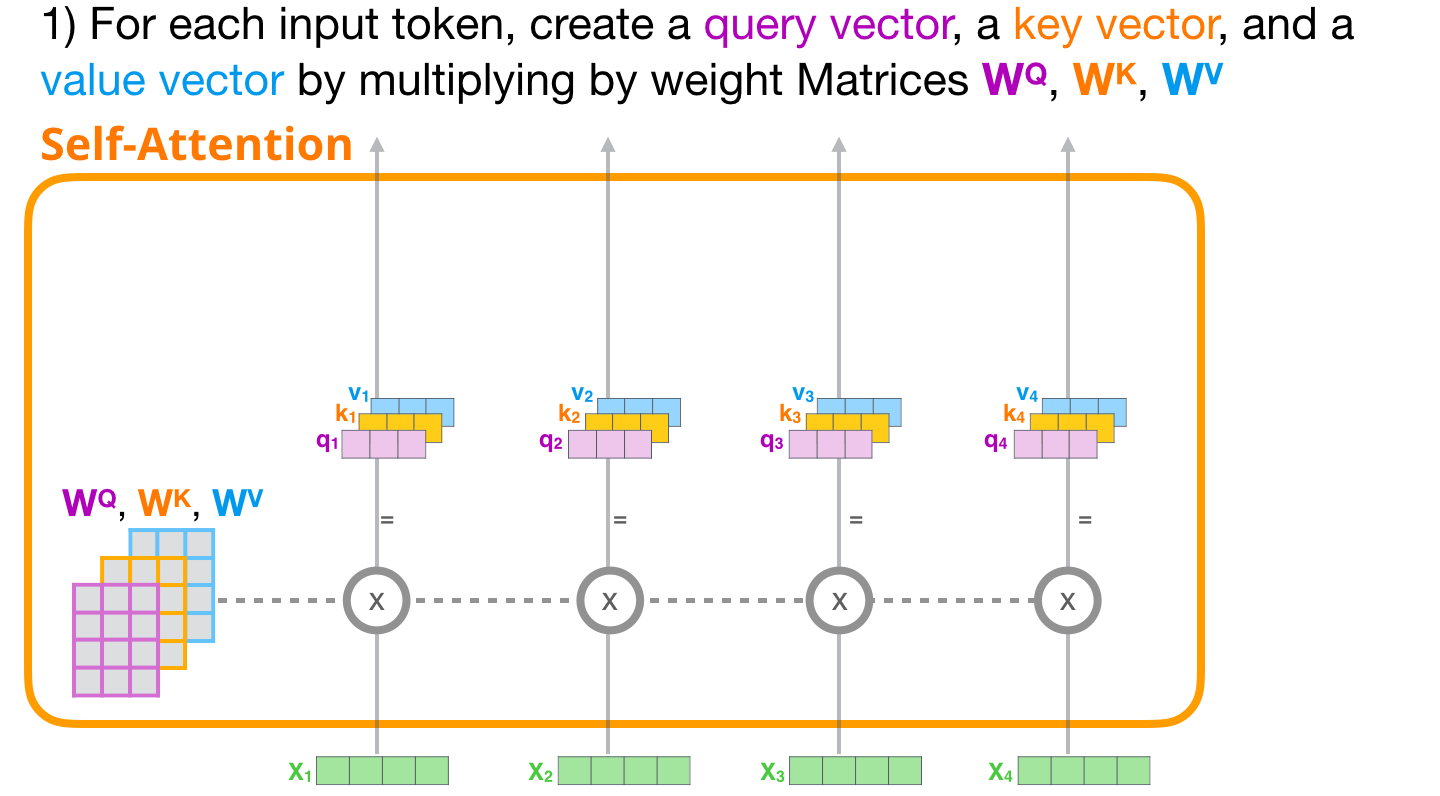
분석하고자 하는 단어의 q 벡터와 문장 내 모든 단어의 k 벡터를 내적하여 각 단어와 관련 정도를 구한다.
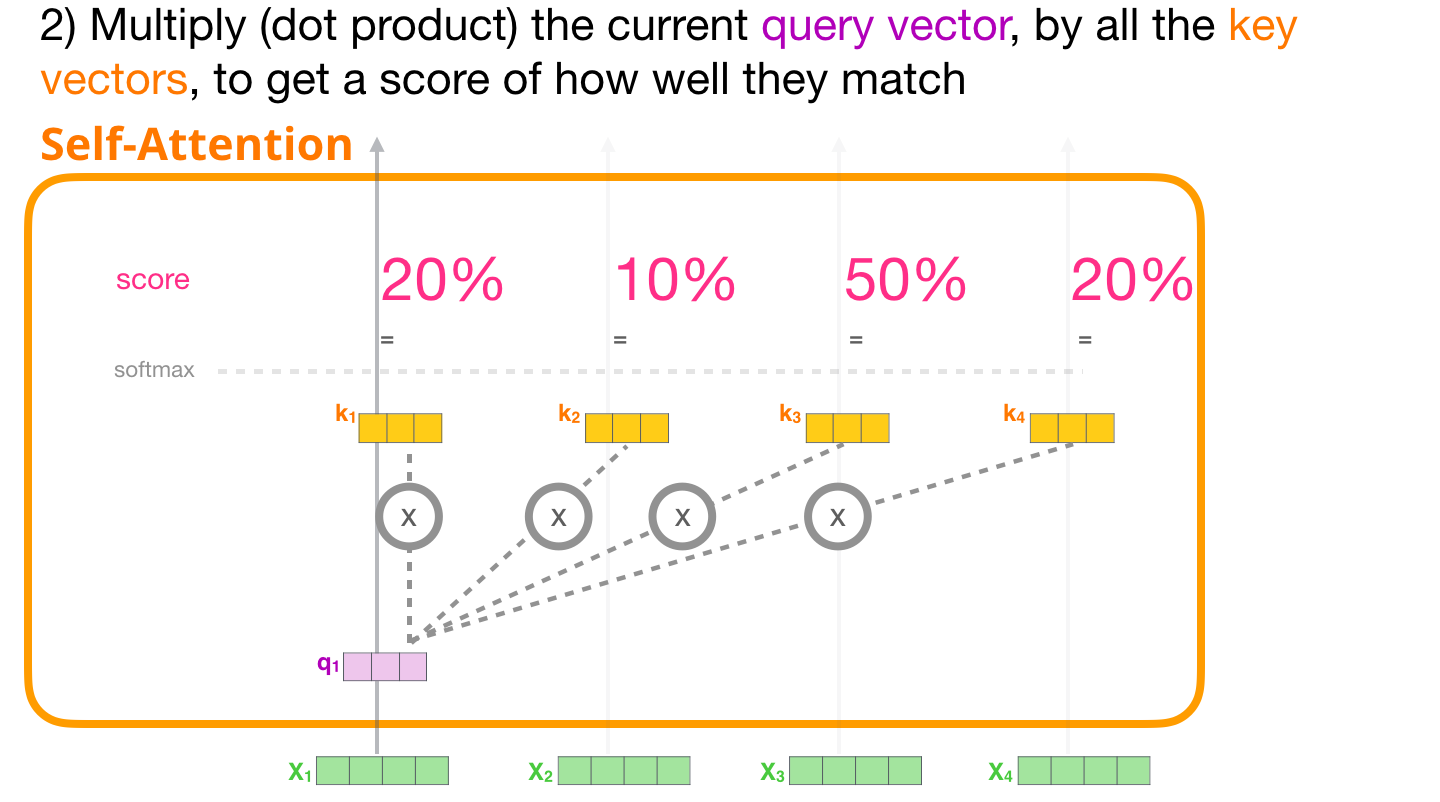
Softmax의 출력값과 v 벡터를 곱해준 뒤 더하면 해당 단어에 대한 Self-Attention 출력값을 얻을 수 있다.
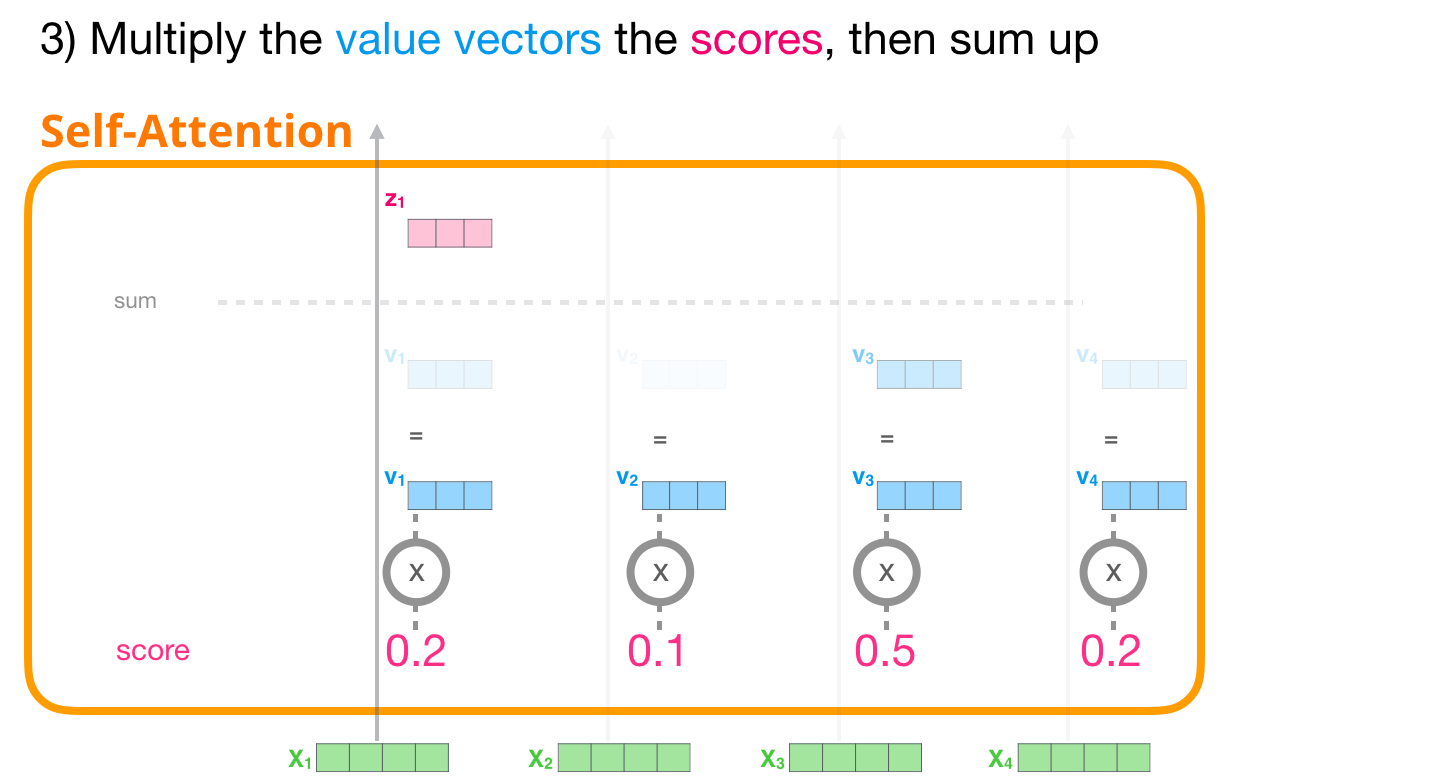
하나의 벡터에 대해서만 살펴봤지만 실제 Attention 계산은 행렬 단위로 병렬 계산된다.
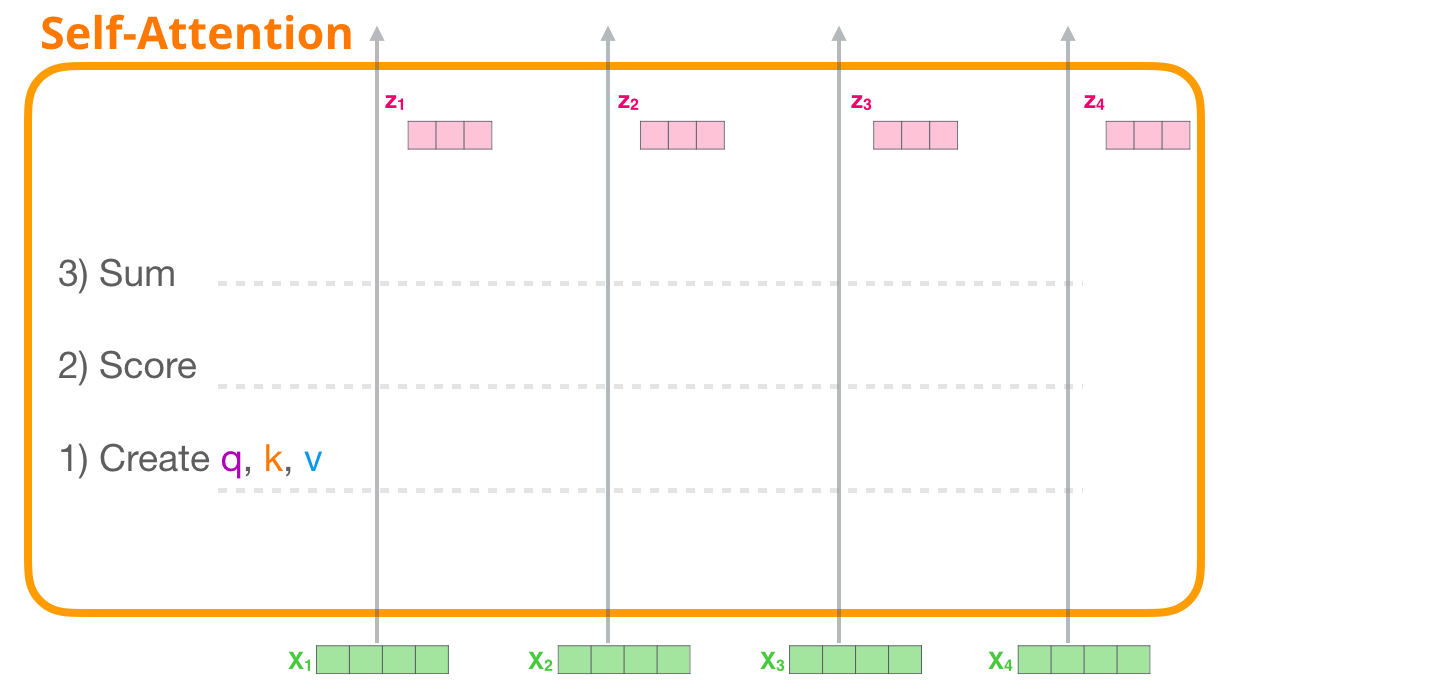
- 실제로 각 벡터는 행렬(Q, K, V)로 한꺼번에 계산된다.
- $W^Q, W^K, W^V$는 학습 과정에서 갱신되는 파라미터로 이루어진 행렬이다.
- 세 행렬과 단어 행렬을 내적하여 Q, K, V를 만들어낸다.
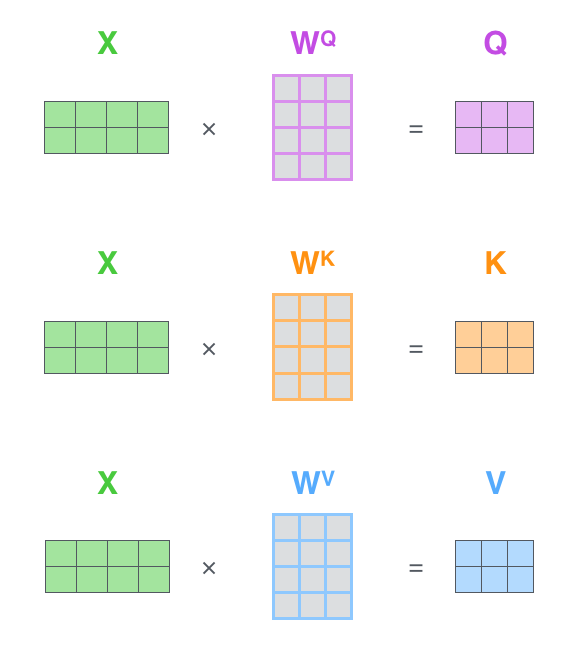
- q 행렬과 k 행렬을 내적한다.
- 결과로 나오는 행렬의 요소를 $\sqrt{d_k}$로 나누어 준다.
- 행렬의 각 요소에 softmax를 취해준다.
- 마지막으로 v 행렬과 내적하면 최종 결과 z 행렬이 반환된다.
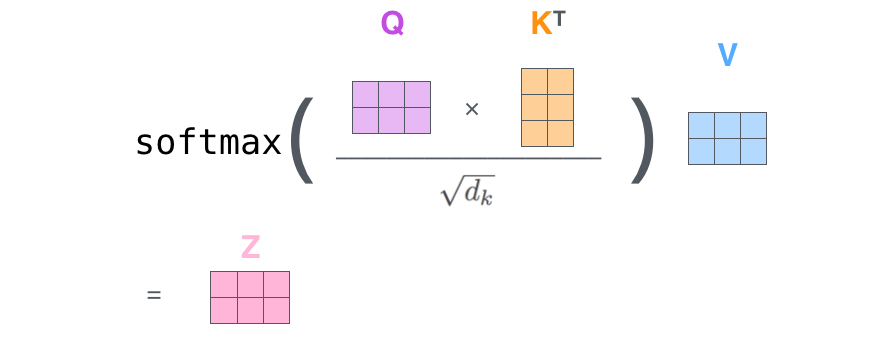
1 | |
Multi-Head Attention
- Self-Attention을 동시에 병렬적으로 실행하는 것이다.
- 각 Head 마다 다른 Attention 결과를 내어주기 때문에 앙상블과 유사한 효과를 얻을 수 있다.
- 8번의 Self-Attention을 실행하여 각각의 출력 행렬 $Z_0, Z_1, \cdots , Z_7$을 만든다.
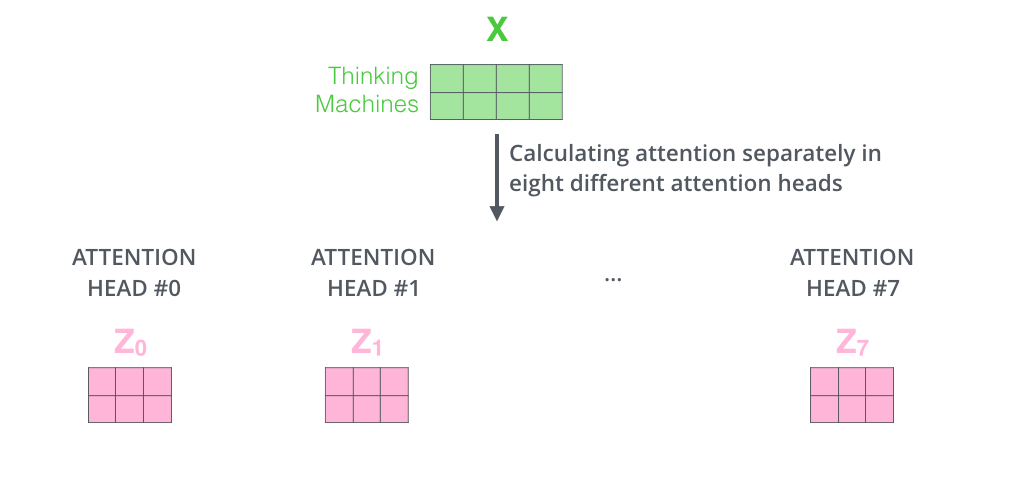
- 출력된 행렬 $Z_n (n=0,\cdots,7)$은 이어붙여진다(Concatenate).
- 또 다른 파라미터 행렬인 $W^0$와의 내적을 통해 Multi-Head Attention의 최종결과인 행렬 $Z$를 만들어낸다.
- 여기서 행렬 $W^0$의 요소 역시 학습을 통해 갱신된다.
- 최종적으로 생성된 행렬 $Z$는 토큰 벡터로 이루어진 행렬 $X$와 동일한 크기(Shape)가 된다.
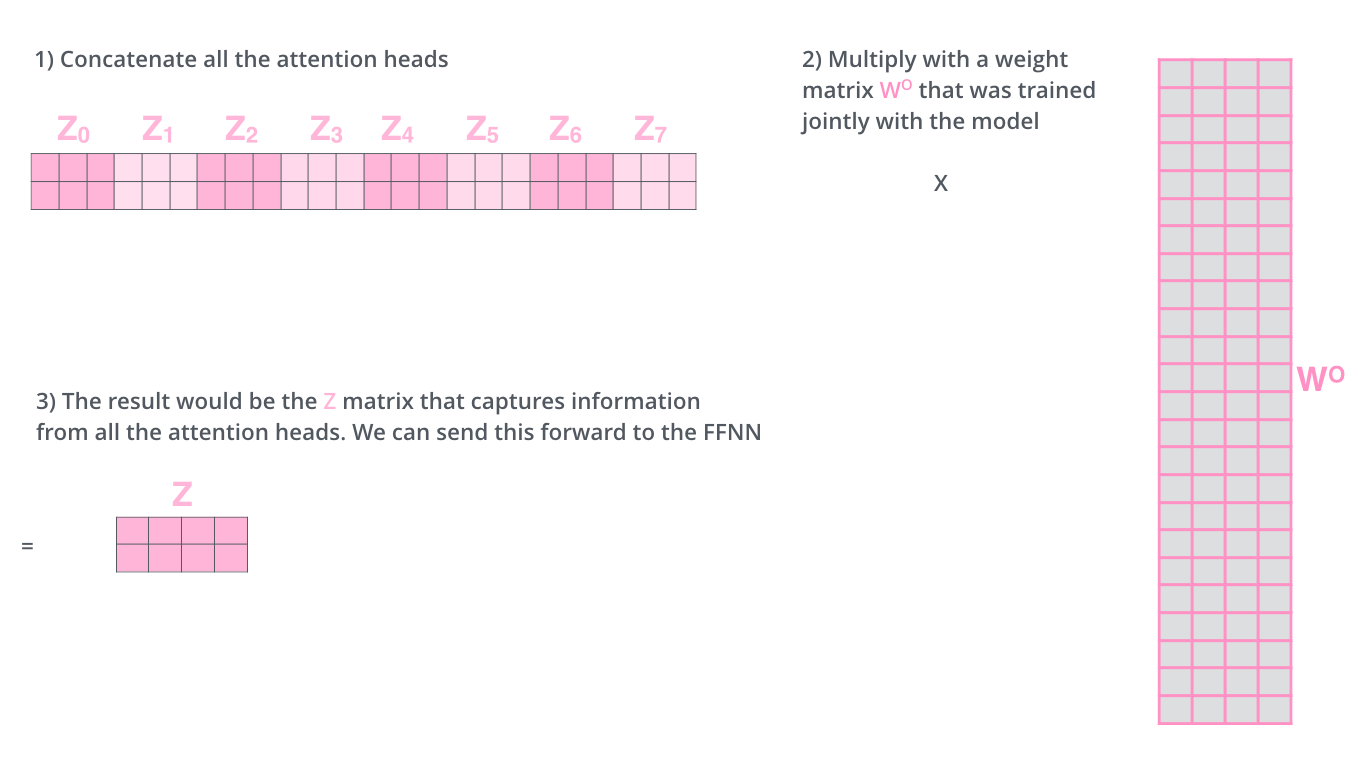
Layer Normalization & Skip Connection
- 트랜스포머의 모든 sub-layer에서 출력된 벡터는 Layer normalization과 Skip connection을 거치게 된다.
- Layer normalization의 효과는 Batch normalization과 유사하다.
- 학습이 빠르고 잘 되도록 한다.
- Skip connection은 역전파 과정에서 정보가 소실되지 않도록 한다.
Feed Foward Neural Network
- 은닉층의 차원이 늘어났다가 다시 원래 차원으로 줄어드는 단순한 2층 신경망이다.
- 활성화 함수로 ReLU를 사용한다.
1 | |
Masked Self-Attention
- 디코더 블록에서 사용되는 특수한 Self-Attention이다.
- 디코더는 Auto-Regressive(왼쪽 단어를 보고 오른쪽 단어를 예측)하게 단어를 생성하기 때문에 타깃 단어 이후 단어를 보지 않고 단어를 예측해야 한다.
- 따라서 타깃 단어 뒤에 위치한 단어는 Self Attention에 영향을 주지 않도록 마스킹(masking)을 해주어야 한다.
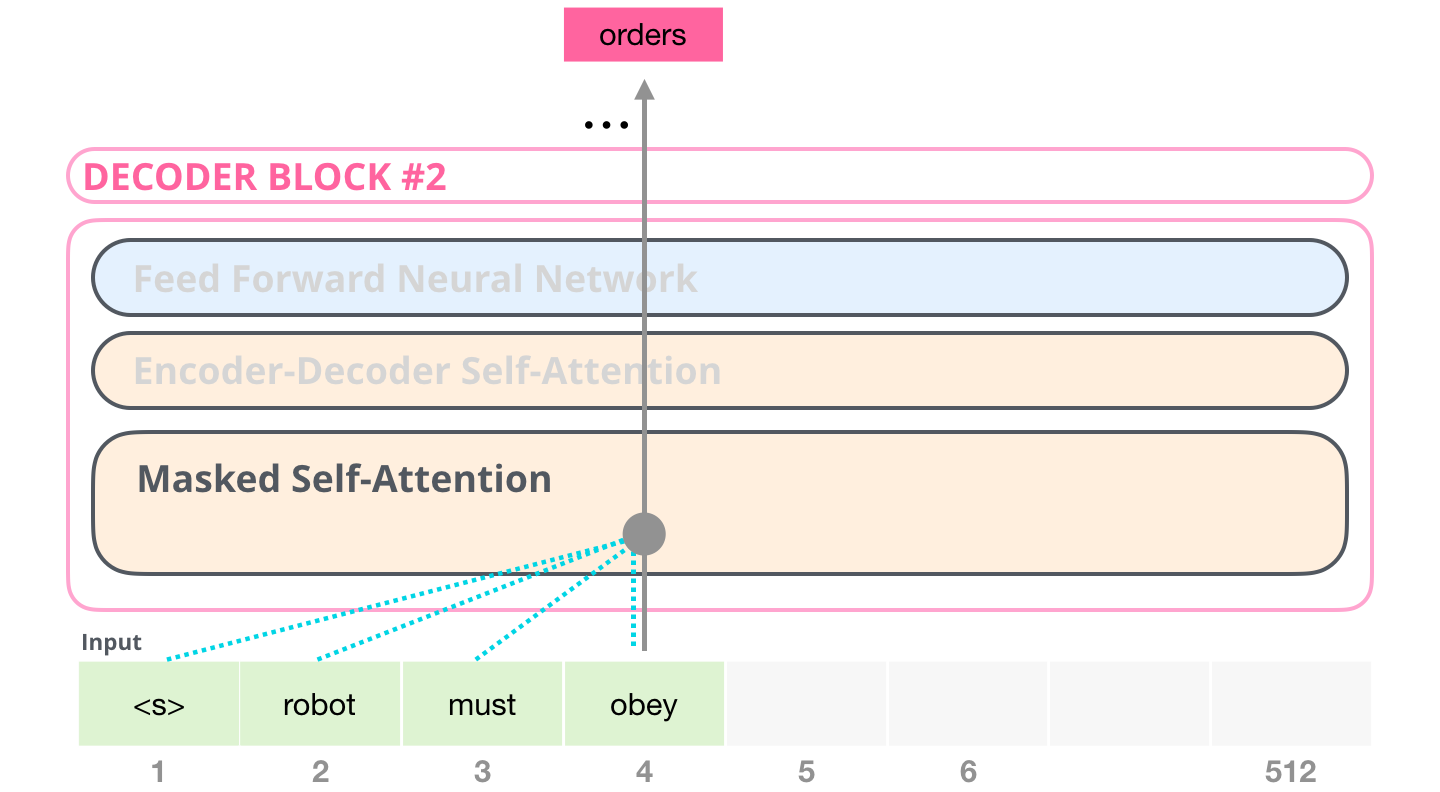
Self-Attention (without Masking) vs Masked Self-Attention
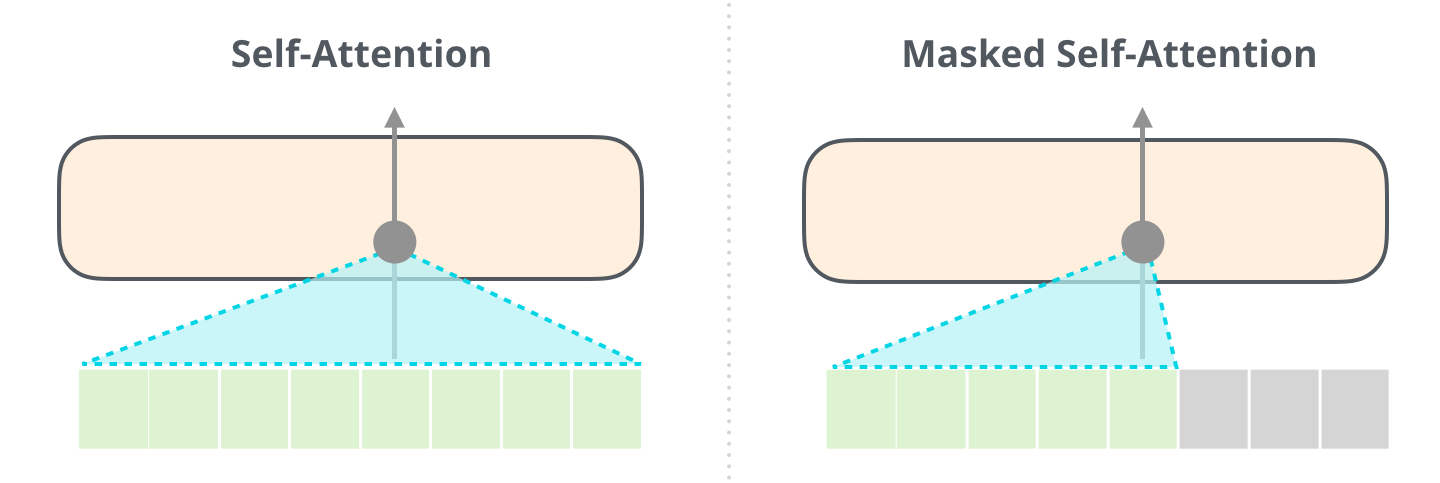
- Softmax를 취해주기 전, 가려주고자 하는 요소에만 $-\infty$에 해당하는 매우 작은 수를 더해준다.
- 이 과정을 마스킹(masking)이라고 하며, 마스킹된 값은 Softmax를 취해 주었을 때 0이 나오므로 Value 계산에 반영되지 않는다.


1 | |
Encoder-Decoder Attention
- 디코더에서 Masked Self-Attention 층을 지난 벡터는 Encoder-Decoder Attention 층으로 들어간다.
- 좋은 번역을 위해서는 번역할 문장과 번역된 문장 간의 관계 역시 중요하다.
- 번역할 문장과 번역되는 문장의 정보 관계를 엮어주는 부분이 이 부분이다.
- 이 층에서는 디코더 블록의 Masked Self-Attention으로부터 출력된 벡터를 Q 벡터로 사용한다.
- K와 V 벡터는 최상위(6번째) 인코더 블록에서 사용했던 값을 그대로 가져와서 사용한다.
- 계산과정은 Self-Attention과 동일하다.
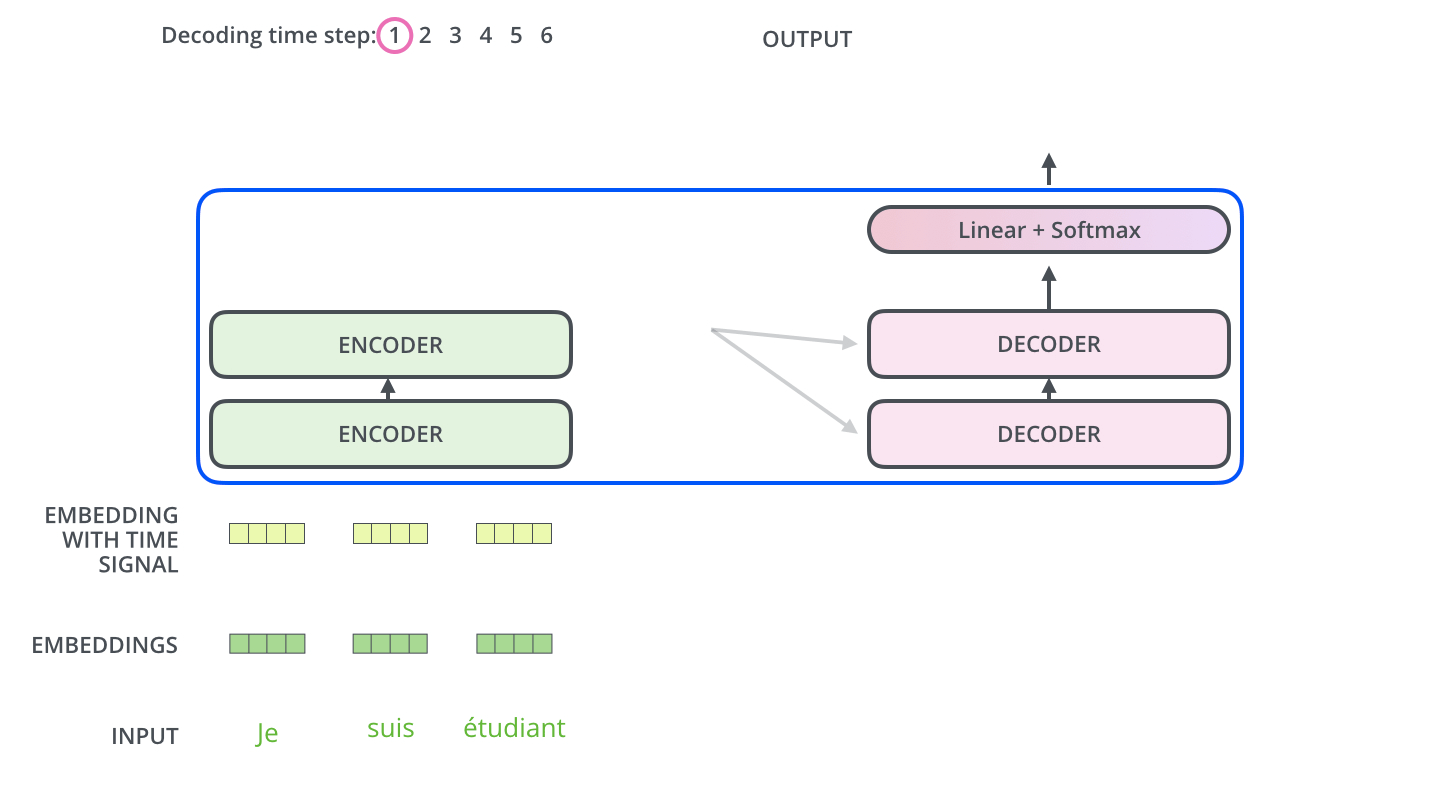
Linear & Softmax Layer
- 디코더 최상층을 통과한 벡터는 Linear 층을 지난 후 Softmax를 통해 에측할 단어의 확률을 구하게 된다.
코드 실습
1 | |
GPT, BERT
- 트랜스포머 구조를 변형하여 만들어진 모델이다.
- 두 모델은 사전 학습된 언어 모델(Pre-trained Language Model)이라는 공통점을 갖고 있다.
- 사전 학습이란 대량의 데이터를 사용하여 미리 학습하는 과정이다. 여기에 필요한 데이터를 추가 학습시켜 모델의 성능을 최적화한다.
- 이런 학습 방법을 전이 학습(Transfer Learning)이라고도 한다.
- 최근 발표 언어 모델은 모두 전이 학습을 적용하고 있다.
GPT(2018.6)

- GPT(Generative Pre-trained Transformer)는 18년 6월에 OpenAI를 통해 발표 되었는데 연이어 발표한 GPT-2(2019.2), GPT-3(2020.6)가 좋은 성능을 보이면서 세간의 주목을 받았다.
- GPT-1, 2, 3의 구조가 모두 동일하지는 않지만 기본적인 뼈대는 동일하다.
- GPT의 구조를 알아보기에 앞서 기본이 되는 아이디어인 사전학습(Pre-training)에 대해 ARABOZA.
사전 학습된 언어 모델(Pre-trained LM)

- 사전 학습 언어 모델은 크게 2가지 과정을 통해 완성된다.
- 첫번째가 사전학습(Pre-traning)이다.
- 책을 많이 읽는 것처럼 레이블링 되지 않은 데이터를 모델이 학습하도록 하는 과정을 사전학습이라고 한다.
- 사전학습이 끝난 모델이 우리가 하고자하는 테스크에 특화된(Task specific) 데이터를 학습한다. 이를 Fine-tuning이라고 한다.
모델 구조
- 아래는 GPT 모델 구조를 나타낸 그림이다.
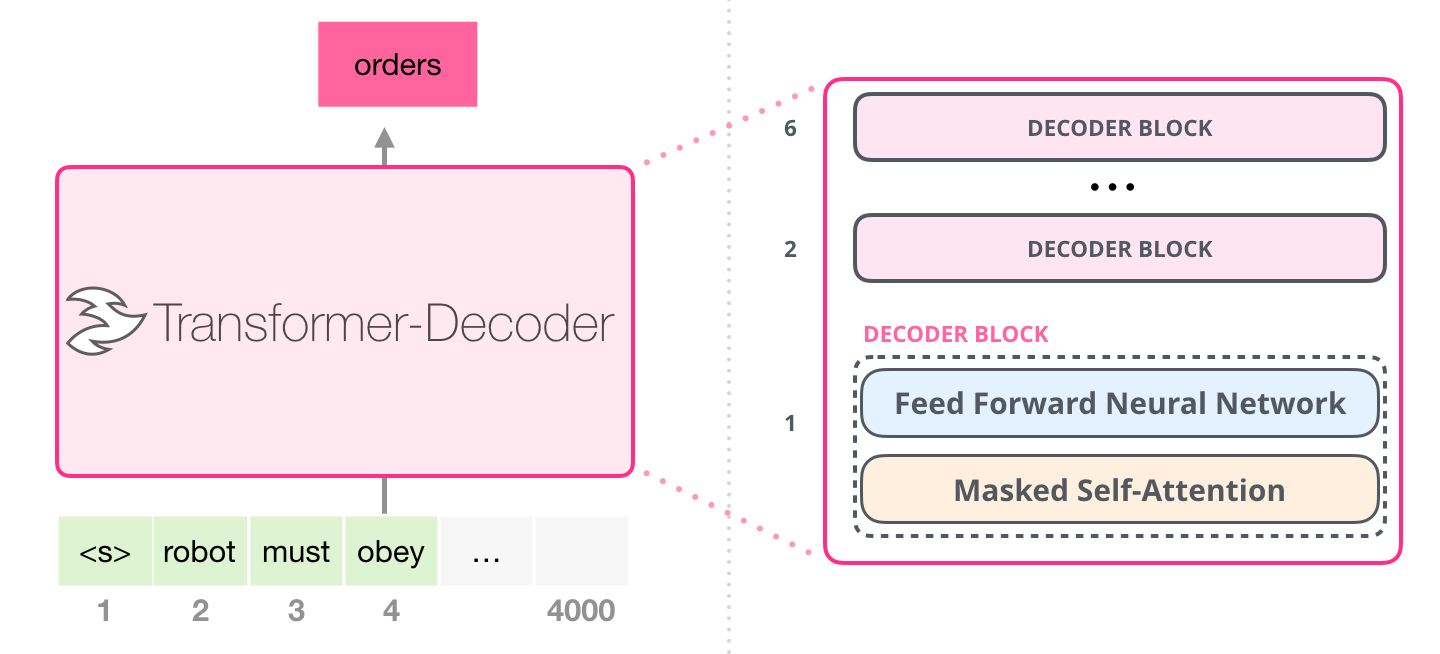
- 트랜스포머의 디코더(Decoder) 블록을 쌓아서 모델을 구성한다.
- GPT에서는 12개의 디코더 블록을 사용했다.
- GPT에서는 인코더를 사용하지 않기 때문에 디코더 블록 내에 2개의 Sub-layer만 있다.
- 트랜스포머의 디코더 블록에는 Masked Self-Attention, Encoder-Decoder Attention, Feed-Forward 층이 있었다.
- 하지만 GPT는 인코더를 사용하지 않기 때문에 Encoder-Decoder Attention 층이 빠지게 된다.
사전 학습(Pre-training)
- 레이블링 되지 않은 대량의 말뭉치 $U = (u_1, \cdots , u_n)$ 에 대해 로그 우도 $L_1$을 최대화하는 방향으로 학습된다.
Fine-tuning
- 기존 모델에서는 테스크에 맞춰 모델 구조를 변경하고 학습을 진행시켰다.
- 하지만 GPT와 같은 사전 학습 언어 모델은 Fine-tuning 과정에서 데이터의 입력 방식만을 변형시키고 모델 구조는 일정하도록 설계되었다.

- Fine-tuning은 레이블 된 말뭉치 $C = (x_1, \cdots , x_m)$에 대하여 로그 우도 $L_2$를 최대화 하는 방향으로 학습한다.
- GPT의 경우 Fine-tuning에서 학습하는 데이터셋이 클 때 보조 목적함수로 $L_1$을 추가하여 $L_3$로 학습하면 더 잘 진행된다.
결과 & 결론
- LSTM, GRU를 사용한 기존 모델보다 자연어 추론(NLI), 질의응답(QA), 분류(Classification) 등의 Task에서 높은 성능을 달성하였다.
- GPT는 사전 학습된 언어 모델을 바탕으로 좋은 성능을 확보할 수 있다는 점과 사전 학습 모델에 Transformer 구조가 더 좋은 성능을 보인다.
BERT(Bidirectional Encoder Representation by Transformer)
- 트랜스 포머의 인코더만을 사용하여 문맥을 양방향(Bidirectional)으로 읽어낸다.
BERT의 구조
- GPT가 트랜스포머의 디코더 블록을 12개 쌓아올린 모델이었다면, BERT는 트랜스포머의 인코더 블록을 12개 쌓아올린 모델이다.

BERT의 Special Token(CLS, SEP)과 입력 벡터

Special Token: CLS, SEP
- BERT에는 CLS와 SEP이라는 두 가지 Special Token이 있다.
-
- 입력의 맨 앞에 위치하는 토큰이다.
- 아래에서 등장할 NSP(Next Sentence Prediction)이라는 학습을 위해 존재한다.
-
- BERT는 사전 학습 시에 텍스트를 두 부분으로 나누어 넣게 된다.
- 첫 번째 부분의 끝자리와 두 번째 부분의 끝자리에 위치한다.
-

Input Vector: Token Embeddings, Segment Embeddings, Position Embeddings
- BERT는 3종류의 임베딩 벡터를 모두 더하여 모델에 입력한다.
BERT의 사전학습(Pre-training) 방법
- BERT 역시 Pre-trained Language Model이기 때문에 사전 학습 이후에 Fine-tuning을 진행하게 된다.
- BERT는 GPT와 다른 방식의 2가지 사전 학습(MLM, NSP)이 적용되었다.
MLM(Masked Language Model)
- BERT는 빈칸 채우기를 하면서 단어를 학습한다.
- BERT는 사전 학습 과정에서 레이블링 되지 않은 말뭉치 중에서 랜덤으로 15% 가량의 단어를 마스킹한다.
- 마스킹된 위치에 원래 있던 단어를 예측하는 방식으로 학습을 진행한다.
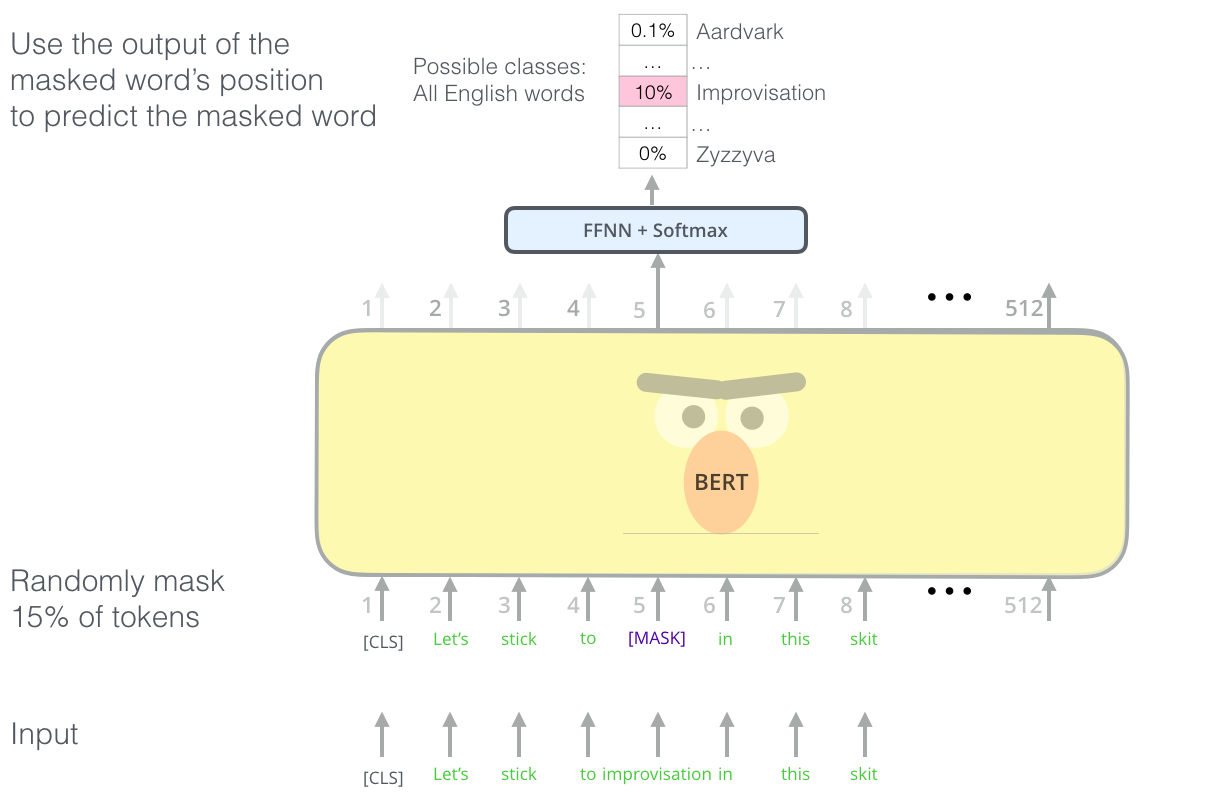
- MLM은 양쪽의 문맥을 동시에 볼 수 있다는 장점이 있다.
- 아래 그림은 GPT와 BERT의 학습 방향을 비교하여 나타낸 그림이다.

- GPT는 ‘거기’라는 단어를 예측할 때 ‘어제 카페 갔었어’의 정보만 볼 수 있다.
- 하지만 BERT는 빈칸에 들어갈 ‘거기’라는 단어를 예측 할 때 ‘어제 카페 갔었어’뿐만 아니라 ‘사람 많더라’의 정보도 참고할 수 있다.
- 이렇게 양방향으로 학습할 경우 단어가 문맥 사이에서 가진 의미를 최대로 학습할 수 있다.
- MLM은 다소 간단한 아이디어지만 단어의 문맥적 의미를 최대로 학습할 수 있도록 함으로써 BERT가 높은 성능을 달성하는 데 커다란 역할을 했다.
NSP(Next Sentence Prediction)
- BERT는 NSP(Next Sentence Prediction) 방식으로도 학습한다.
- NSP는 모델이 문맥에 맞는 이야기를 하는지 아니면 동문서답을 하는지를 판단하며 학습하는 방식이다.
- SEP 토큰 왼쪽의 문장과 오른쪽의 문장이 바로 이어지는 문장일 경우 CLS 토큰의 출력이
IsNext로 되도록 학습한다. - 두 문장이 이어지지 않는 쌍일 경우 출력 벡터가
NotNext로 나오도록 학습한다.

- 아래는 드라마 대본을 예시로 NSP가 어떻게 작동하는 지를 나타낸 그림이다.


- NSP 역시 간단한 아이디어다.
- 모델이 문장과 문장 사이의 관계를 학습할 수 있도록 함으로써 질의응답(QA), 자연어 추론(NLI) 등 문장 관계를 이해해야만 하는 복잡한 Task에서 좋은 성능을 나타내는 역할을 했다.
Fine-tuning
- BERT 역시 모델의 구조는 그대로 유지한 채 데이터를 입력하는 형태만 바꾸어서 Fine-tuning을 실시한다.
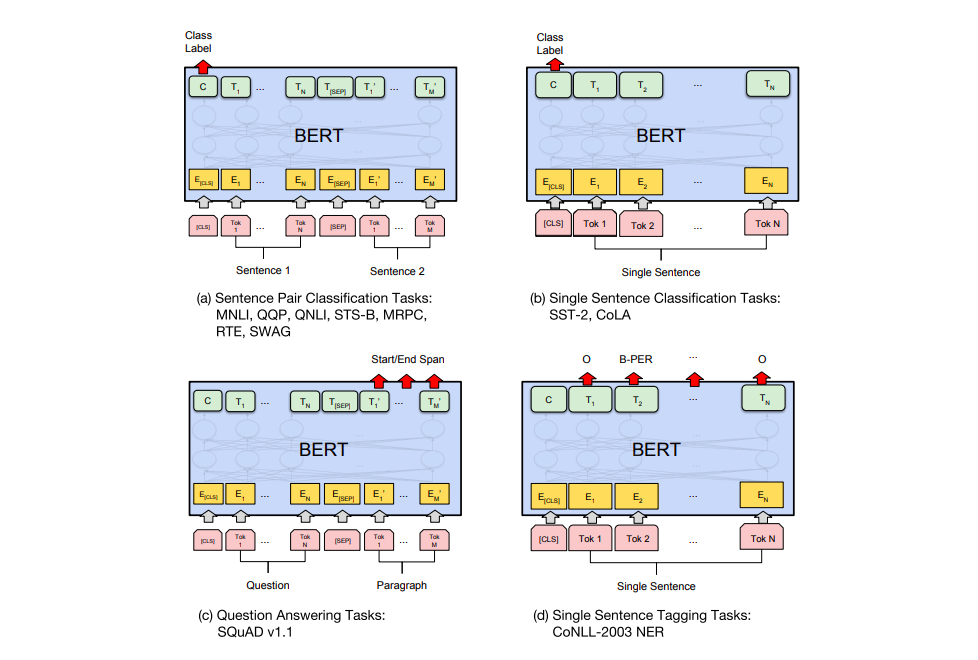
- (a)는 “Sentence” 쌍을 분류하는 테스크이다.
[SEP]으로 나눠진 “Sentence” 쌍을 입력받아[CLS]가 출력하는 클래스를 반환한다. - (b)는 감성분석 등 하나의 문장을 입력하여
[CLS]로 해당 문장을 분류하는 테스크이다. - (c)는 질의 응답 테스크이다. 질문과 본문에 해당하는 단락을
[SEP]토큰으로 나누어 입력하면 질문에 대한 답을 출력하도록 한다. - (d)는 품사 태깅(POS tagging)이나 개체명 인식(Named Entity Recognition, NER) 등의 테스크이다. 입력받은 각 토큰마다 답을 출력한다.
결과 & 결론
- BERT는 간단한 사전 학습 아이디어로 많은 테스크에서 SOTA를 달성하였다.
- 단순한 아이디어를 통해 엄청난 성능을 달성하였기에 당시 많은 충격을 주었다.
- 이후로도 BERT를 개선하기 위한 연구가 많이 진행되었다.
- 특히 MLM을 통해 BERT가 좋은 성능을 달성한 뒤로 텍스트에 노이즈를 준 후 이를 다시 맞추는(Denoising) 방법에 대해 많은 연구가 진행되었다.
Post BERT(최근 NLP 연구 방향)
더 큰 모델 만들기
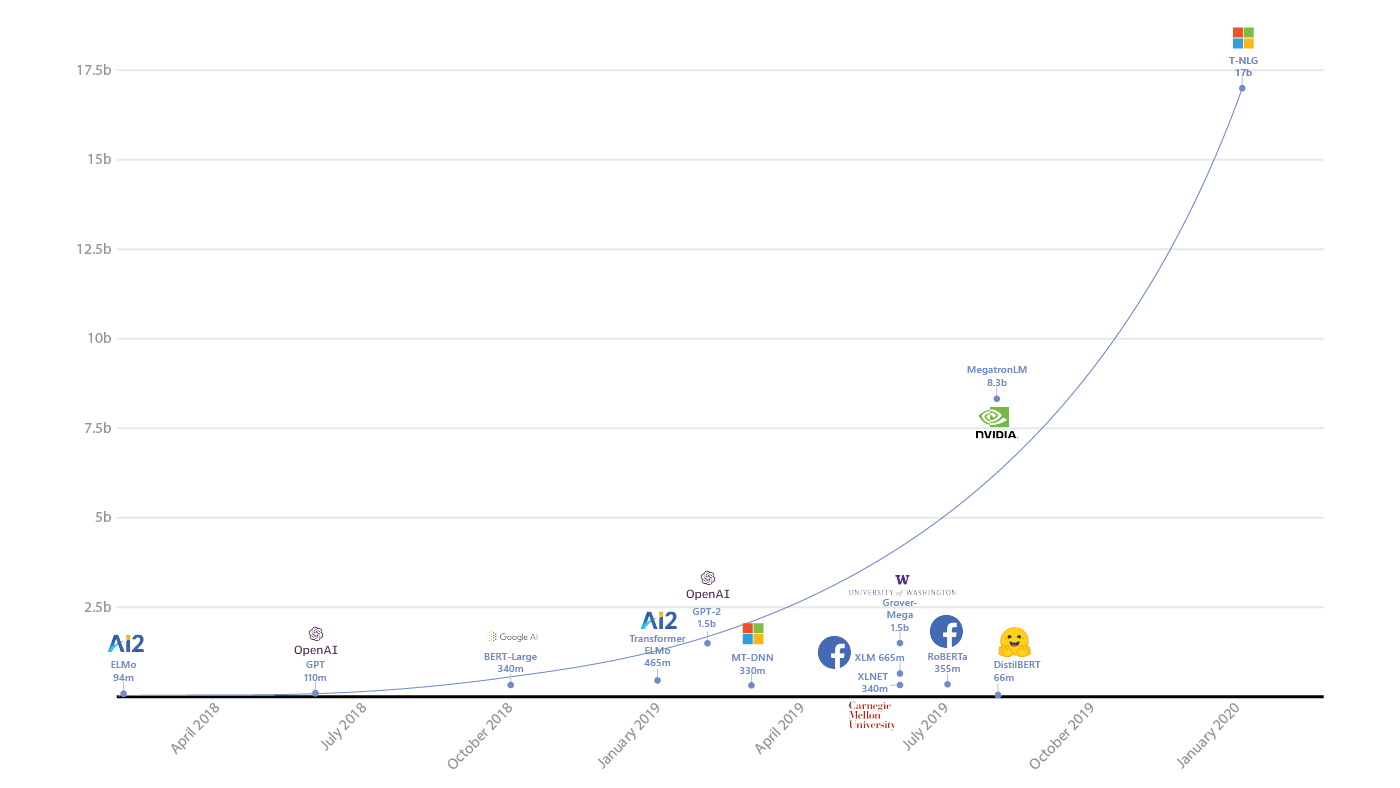
- GPT와 BERT 이후로도 수많은 모델이 발표되어 왔다.
- 두 모델 이후로 발표되고 있는 모델의 주요 경향성 중 하나는 모델 크기 키우기이다.
- 위 그림에서 볼 수 있듯 GPT와 BERT 이후 발표되는 모델의 파라미터 수는 기하급수적으로 증가하고 있다.
- 크기가 커지면 사전 학습에 따른 비용이 많이 들고 그만큼 많은 학습 데이터를 확보해야 한다.
- 이런 제약사항 때문에 초대형 모델은 학계보다는 구글, 페이스북 같은 대기업에서만 이루어지고 있다.
- 큰 모델에 비해 그렇지 못한 모델이 좋은 성능을 보장하지 못하기 때문에, 학계에서는 상대적으로 뒤처질 수 밖에 없게 된다.
- 이런 사태가 계속되면서 크기만 커지는 모델에 대한 우려의 시각도 있다.

더 좋은 학습 방법 적용하기
- 여전히 더 좋은 학습 방법을 연구하고자 하는 움직임도 계속되고 있다.
- 특히 기존 GPT나 BERT의 단점을 보완하는 방향으로 많은 연구가 진행되고 있다.
- 트랜스포머의 디코더 블록만을 사용한 GPT는 상대적으로 자연어 생성과 관련된 테스크에,
인코더 블록만을 사용한 BERT는 자연어 이해와 관련된 테스크에 특화되어 있다. - GPT와 같이 순차적으로 자연어를 생성하는 모델에는 AR(Auto-Regressive)한 방법이 적용되었고,
BERT와 같이 노이즈를 맞추어가는 방식으로 자연어를 이해하는 모델에는 AE(Auto-Encoder)한 방법이 적용되었다. - 두 모델이 사용했던 방법을 결합(AE+AR)한 모델로 XLNet이나 BART가 있다.
- 두 모델 모두 자연어 이해와 생성 모두에서 좋은 성능을 보이며 특히 BART는 요약 테스크에서 좋은 성능을 보인다.
- 다른 방향의 개선으로는 BERT의 Noising 방법을 어렵게 만든 모델이 있다.
- 대표적인 모델로 Masking 방법에 변화를 주는 SpanBERT, RoBERTa와 같은 모델이 있다.
- 아래는 BART 모델이다.
- AE와 AR이 모두 적용되었다.
- 게다가 BART는 Masking 뿐 아니라 Permutation, Infilling 등 다양한 Noising 방법이 적용되었다는 특징을 가지고 있다.

보다 가벼운 모델 만들기
- GPT와 BERT 기본 모델이라도 크기가 꽤 크다 보니 사이즈를 줄이되 성능은 보전하는 경량화로도 많은 연구가 진행되고 있다.
- DistillBERT, ALBERT(A Light BERT) 나 ELECTRA가 이런 방향으로 연구된 대표적인 모델이라고 할 수 있다.
- 세 모델 모두 각자만의 방법을 이용해서 BERT의 크기(=파라미터 수)를 많이 줄이고 성능은 어느정도 보존함으로써 모델 효율성을 높였다.
- 아래는 ELECTRA의 모델 구조이다.
- 다음 시간에 배울 GAN에 등장하는 방법론을 적용하여 BERT보다 적은 리소스를 활용하여 더 높은 성능을 기록하였다.

여러 방면에서의 다양한 시도
다양한 테스크를 수행할 수 있는 모델(Meta Learning)
- T5나 GPT-3와 같은 모델은 하나의 모델로 다양한 테스크를 수행할 수 있는 모델이다.
- 특히 GPT-3는 Few-shot learning 방법론을 적용한 모델로 적당한 길이의 제시문만 주어주면 Fine-tuning 없이도 엄청나게 좋은 성능을 보여준다.
- N-shot learning에 대해서는 아래 자료를 참고하면 된다.
- 파인튜닝(finetuning) : 다운스트림 테스크에 해당하는 데이터 전체를 사용한다. 모델 전체를 다운스트림 데이터에 맞게 업데이트한다.
- 제로샷러닝(zero-shot learning) : 다운스트림 테스크 데이터를 전혀 사용하지 않는다. 모델이 바로 다운스트림 테스크를 수행한다.
- 원샷러닝(one-shot learning) : 다운스트림 테스크 데이터를 한 건만 사용한다. 모델 전체를 1건의 데이터에 맞게 업데이트한다. 업테이트 없이 수행하는 원샷러닝도 있다. 모델이 1건의 데이터가 어떻게 수행되는지 참고한 뒤 바로 다운스트림 테스크를 수행한다.
- 퓨샷러닝(few-shot learning) : 다운스트림 테스크 데이터를 몇 건만 사용한다. 모델 전체를 몇 건의 데이터에 맞게 업데이트한다. 업데이트 없이 수행하는 퓨삿러닝도 있다. 모델이 몇 건의 데이터가 어떻게 수행되는지 참고한 뒤 바로 다운스트림 테스크를 수행한다.
다국어(Multilingual) 모델
- 다국어 모델 역시 열심히 연구되고 있는 분야이다.
- 일반적인 언어 모델의 경우 단일 말뭉치로만 사전 학습을 진행하는 경우가 많다.
- 그렇기 때문에 사전 학습된 언어 외에 다른 언어를 사용하면 성능이 급격히 저하되는 경우가 많다.
- 예를 들어, 영어로 학습된 GPT-3 모델에 한국어를 집어넣으면 거의 이해하지 못하게 된다.
- 이러한 문제를 뛰어넘기 위해 다양한 언어를 넘나들며 사용할 수 있는 모델이 연구되고 있는데 이를 다국어 모델 이라고 한다.
- 대표적인 다국어 모델로는 mBART(multi-lingual BART), mT5(multi-lingual T5) 등이 있다.
자연어를 넘어(1): 컴퓨터 비전(Computer Vision, CV)에서의 트랜스포머
- 트랜스포머는 원래 자연어처리 중 번역 테스크에 적용하기 위해서 나온 모델이었다.
- 하지만 최근에는 컴퓨터 비전 테스크인 이미지 처리에서도 트랜스포머를 적용하고자 하는 움직임이 나타나고 있다.
- ViT(Vision in Transformer) 논문에서는 컴퓨터 비전 분야에서 SOTA인 CNN 계열 모델보다 트랜스포머가 더 좋은 성능을 나타냈다고 말하고 있다.
- 아직 컴퓨터 비전 분야에서는 CNN에 비해 개발 속도가 더딘 편이지만, 트랜스포머를 사용하여 비전과 자연어 모두 정복하기 위한 다양한 시도가 지금도 진행되고 있다.
자연어를 넘어(2): 멀티 모달(Multi-modal) 모델
- 지난 1월에는 GPT를 발표했던 OpenAI에서 DALL-E 와 CLIP 이라는 재미있는 모델을 발표했다.
- 이 모델은 텍스트(문장)를 입력받아 상응하는 이미지를 생성한다.
- 아래는 DALL-E 가 “an armchair in the shape of an avocado” 라는 문장을 입력받은 뒤 출력한 이미지이다.

- 이렇게 자연어를 넘어 다양한 매체로 기계와 소통하는 태스크를 멀티모달(Multi-Modal)이라고 합니다.
- 트랜스포머가 자연어처리 뿐만 아니라 컴퓨터 비전에 대해서도 좋은 성능을 보이기 때문에 트랜스포머를 활용한 멀티모달 연구도 활발하게 진행되고 있다.
References
- 트랜스포머
- The Illustrated Transformer
- 번역
- Paper (Attention is All You Need)
- GPT
- The Illustrated GPT-2 (Visualizing Transformer Language Models)
- Paper (Improving Language Understanding by Generative Pre-Training)
- BERT
- The Illustrated BERT, ELMo, and co. (How NLP Cracked Transfer Learning)
- 번역
- Paper (Pre-training of Deep Bidirectional Transformers for Language Understanding)